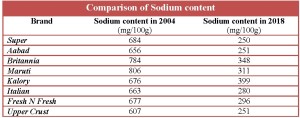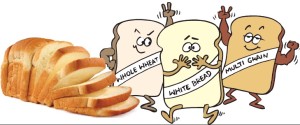Aug.18: COVER STORY
Are you concerned about the quality of bread?
We tested 10 popular brands.Â
Find out the sodium content of your favourite brand.
Bread is the most common, convenient and cheap form of processed food with a history dating back 12,000 years. It is a very palatable source of energy, being easy to digest and giving satiety. Bread is available in many variants today – white, brown, whole wheat, milk, atta, multigrain bread and others.
How good is the bread available in the market in terms of quality? To find the answer we tested 10 popular brands of white bread on the basis of various parameters. We are happy to report that all brands conformed to the parameters set by the Bureau of India Standards (BIS) and Food Safety and Standards Authority of India (FSSAI). Another piece of heartening news is that compared to our test findings of bread in 2004, the sodium levels are much lower now.   Â
KEY FINDINGSÂ (See table for detailed results)
- The brands showed sodium content in the range of 250 mg/100g (Super) to 404 mg/100g (Amul). According to the UK Food Standard Agency (FSA), sodium content of more than 550 mg/100g in a product is high. In 2004, we tested 14 brands of white bread and all had high sodium levels ranging from 503 mg/100g to 806 mg/100g. A high amount of sodium is undesirable, especially for people suffering from hypertension,which in turn is linked to heart disease and stroke.
- In all 10 brands, the total solid content complied with the BIS limit (not less than 60% by mass) with results ranging from 62-70%. This parameter indicates moisture content in bread. If it is high, it indicates improper baking, which makes the bread susceptible to fungal growth.
- The pH was found to be within the BIS limit (between 5.0 and 6.0) in all brands. The results ranged from 5.0 to 5.9. Bread has a slightly acidic pH due to the leavening agents. A lower pH (<5.0) indicates a higher acidity and thus pronounced yeast flavor which is an undesirable sensory quality.
- All brands complied with the BIS as well as the FSSAI limits of not more than 0.1% by mass for acid insoluble ash. A high value suggests inferior quality as it indicates the presence of dust, dirt and stones. These get mixed during processing or are present in the parent material.
- All brands showed negligible amount of crude fibre and complied with the BIS limit (not more than 0.5% by mass). High amount of crude fibre is an indication of adulteration with extraneous matter of plant origin.
- Potassium bromate was found to be absent in all ten brands as prescribed by the FSSAI. Earlier used as a flour improver, it has now been banned from use in bakery products due to its carcinogenic properties.
- All the brands passed the test for alcoholic acidity with results below the limit of 7.5 ml as prescribed by the FSSAI. The highest amount of alcoholic acidity was found in Maruti (3.9) and the least in Super (3.1). This parameter indicates the age or freshness of the wheat flour. A higher value means a poor quality product.
Best Buys
Our Best Buy is decided on the basis of Overall Score and Price. Three brands – Super, Aabad and Upper Crust – received the highest score of 100. However, Upper Crust was costlier by Rs. 10. Hence Super and Aabad are our Best Buys.
Sodium content: Since eight of the white bread brands tested in 2004 were also tested in 2018 we decided to compare the sodium levels. 
How healthy is bread?
It is advisable to eat bread in moderation for the following reasons:
- White bread is made of highly-processed, simple carbohydrates. Consuming too much can contribute to obesity, heart disease and diabetes.
- White bread is nutritionally poor as calcium, vitamin B and iron as well as fibre are lost in the refining process.
- Bread is easily digested and rapidly spikes blood sugar and insulin levels. This can lead to the blood sugar ‘roller coaster’ and stimulate overeating.
- Even whole-grain bread contains added salt, sugar and preservatives that make it unhealthy.
- Eating bread can cause health problems for those who are sensitive to gluten.
- When gluten is digested it creates opioid peptides which makes bread addictive.
- Bread does not contain any nutrients that can’t be found in other foods.
Labelling claims
Only two brands – Upper Crust and Premvati – mentioned the date of manufacture.  Italian did not mention the batch number as required. However, all the brands mentioned the best before date.
All brands mentioned that the product was vegetarian. The ingredients listed were wheat flour, yeast, sugar, salt, vegetable oil, water, preservatives, flour treatment agents, permitted colours, improvers, emulsifiers and vitamins. Only three brands mentioned the sodium content – Amul, Kalory and Premvati.
Areas of Action
- It should be made mandatory for manufacturers to mention values of sodium content on the label. According to the FSS (Packaging and Labelling) Regulations 2011, manufacturers are required to provide nutritional information on ‘energy, protein, carbohydrate, sugar and fat’ but not sodium.
- As per the regulations for food articles with shelf life of not more than 7 days, the date of manufacture need not be mentioned on the label but the ‘Use by date’ should be mentioned. However, from the consumer’s point of view mentioning date of manufacture should be mandatory.
- Manufacturers should try to improve the nutritive value of bread in terms of fibre content, vitamins and minerals.
- Consumers must be made aware about the harmful effects of overconsumption of processed foods such as bread and be encouraged to go for healthier variants like whole wheat and multigrain bread.
Tips for consumers
- Squeeze bread to check sponginess and ascertain freshness.
- Store bread in a breadbox, a paper bag or sealed plastic bag.
- Avoid putting unused bread in the refrigerator. Refrigeration may retard the growth of fungi, but increases the staling process. However, deep freezing retards both.
- Even if you see mould on only a slice or two, throw the whole loaf away.
- Toasting is an ideal way to refresh the flavour of bread.
Grahak Sathi’s conclusion
It is good news for consumers that our testing of 10 bread brands revealed positive results. Not only did all the brands conform to the standards, they also had low sodium levels. However, bread itself (especially white bread, which we have tested) is not a healthy food. Consume it in moderation.






